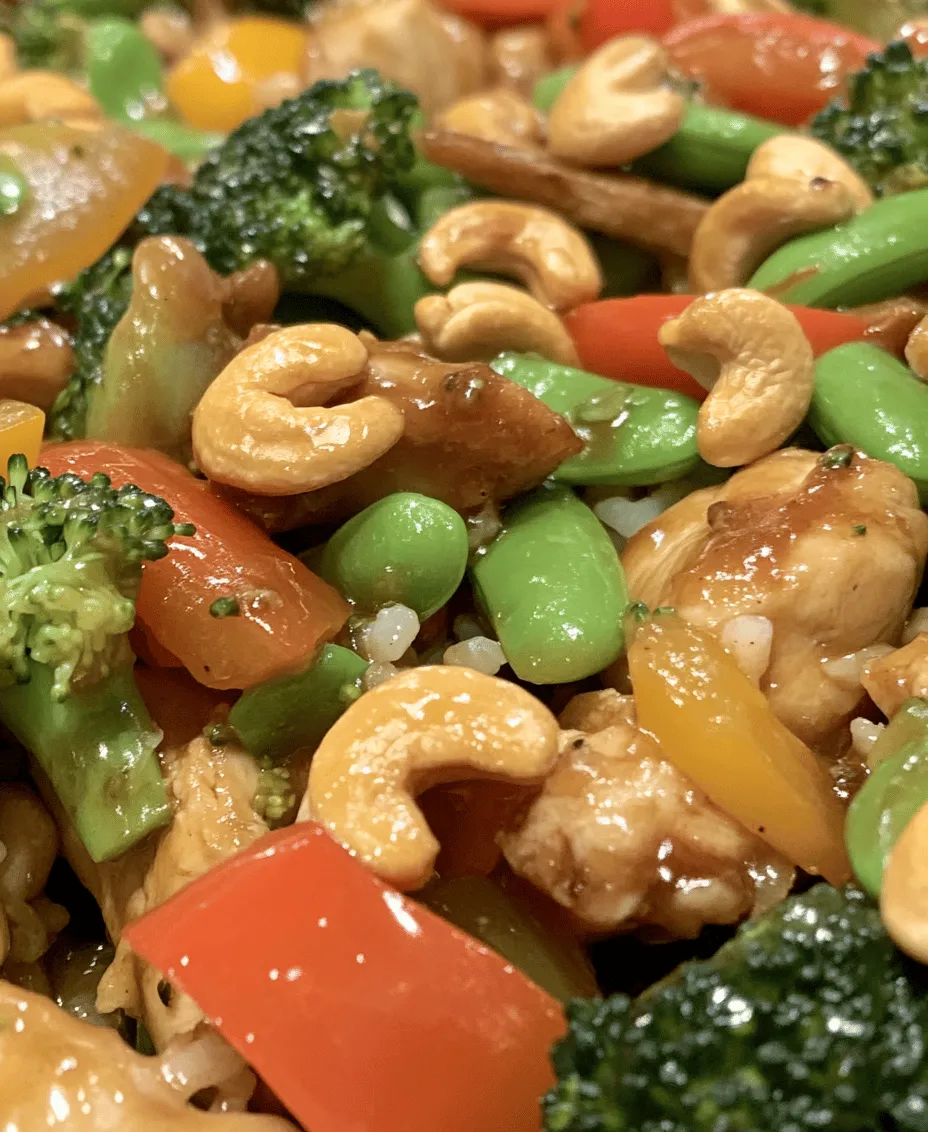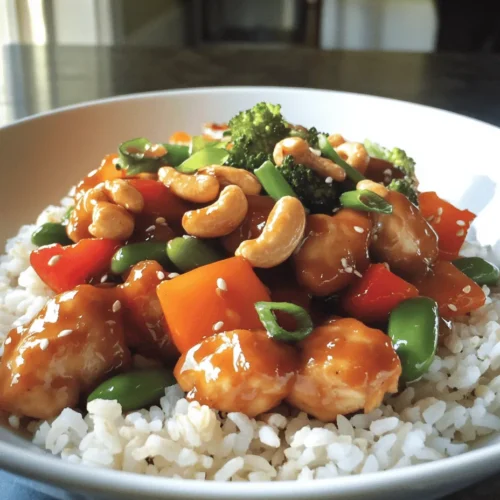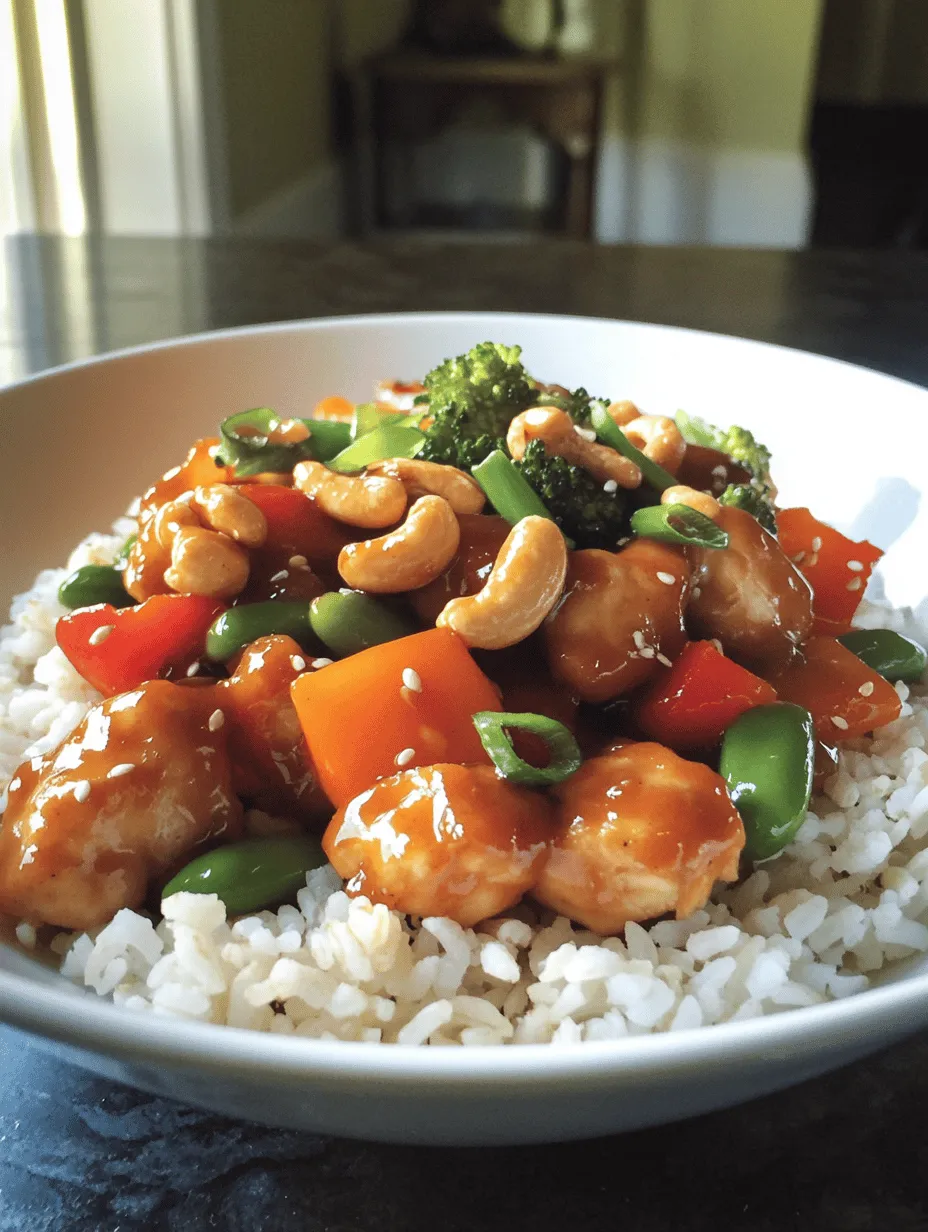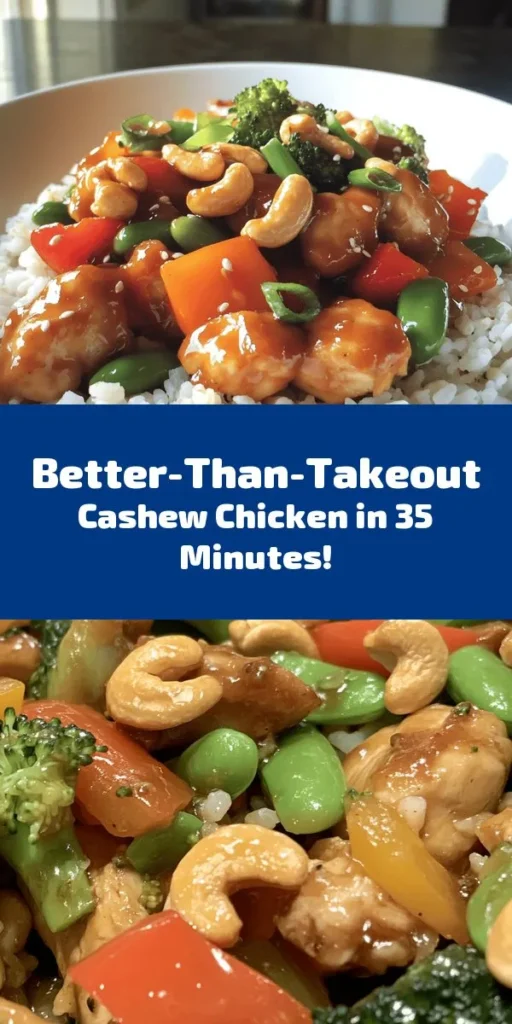Introduction
In today’s fast-paced world, takeout cuisine has become a beloved staple for many. The convenience of ordering a meal from your favorite restaurant is hard to resist, especially when you’re craving something flavorful and satisfying. However, as more people become health-conscious, the desire for healthier homemade alternatives has surged. Enter the “Better-Than-Takeout Cashew Chicken” recipe, a dish that strikes the perfect balance between indulgence and nutrition, allowing you to enjoy restaurant-quality flavors right from your own kitchen.
This delectable dish features tender chicken stir-fried with crunchy roasted cashews and vibrant vegetables, all enveloped in a savory sauce that packs a punch. Not only is it loaded with protein and healthy fats, but it also offers a rainbow of nutrients thanks to the colorful veggies. The beauty of making Cashew Chicken at home lies in its ease of preparation and the ability to customize the dish to suit your taste preferences. Whether you prefer more vegetables, a spicier sauce, or even a different protein altogether, this recipe provides a versatile foundation for your culinary creativity.
Understanding the Ingredients
To truly appreciate the flavor and texture of Better-Than-Takeout Cashew Chicken, it’s essential to understand the key ingredients that come together to create this dish. Each component plays a vital role in making the final product not only delicious but also nutritious.
Chicken: Source of Protein and Heartiness
The star of this dish is undoubtedly the chicken. Using boneless, skinless chicken breast or thigh meat provides a lean source of protein that is both satisfying and filling. Chicken is versatile and absorbs flavors beautifully, making it the perfect canvas for the rich sauce and seasonings used in this recipe. By marinating the chicken, you enhance its flavor and tenderness, ensuring that every bite is juicy and flavorful.
Roasted Cashews: Adding Crunch and Healthy Fats
Roasted cashews are a key ingredient that adds an irresistible crunch to the dish. They are not only a delicious addition but also offer healthy fats, which contribute to a satisfying mouthfeel. Cashews are rich in essential nutrients, including magnesium, copper, and healthy monounsaturated fats. Their creamy texture complements the chicken and vegetables, creating a delightful contrast that elevates the overall dining experience.
Vegetables: Nutritional Benefits and Color Contrast
The inclusion of colorful vegetables not only enhances the visual appeal of the dish but also boosts its nutritional profile. Fresh bell peppers, broccoli, snap peas, and carrots are excellent choices that add vitamins, minerals, and fiber. The vibrant colors not only make the dish more enticing but also provide a range of health benefits. For instance, bell peppers are rich in vitamin C, while broccoli is known for its cancer-fighting properties. By incorporating a variety of vegetables, you can create a well-rounded meal that nourishes both the body and the palate.
Sauces: Flavor Complexity and Depth
The sauce is what truly brings this dish to life. A well-crafted sauce can elevate simple ingredients into a sumptuous meal. In the Better-Than-Takeout Cashew Chicken, a combination of soy sauce, oyster sauce, and a touch of sesame oil creates a savory and slightly sweet flavor profile that perfectly coats the chicken and vegetables. These sauces work harmoniously to deliver layers of umami and depth, ensuring that each bite is bursting with flavor. Preparing the sauce in advance allows the ingredients to meld together, resulting in a more complex taste.
Preparation Techniques
Before diving into the cooking process, it’s crucial to understand the preparation techniques that will set the stage for a successful and delicious dish. Proper preparation not only enhances the flavors but also improves the texture of the finished product.
Importance of Marinating Chicken with Cornstarch
One of the most important steps in preparing the chicken for your Cashew Chicken dish is marinating it with cornstarch. This technique may seem simple, but it plays a significant role in achieving that coveted restaurant-quality texture. The cornstarch creates a light coating around the chicken that helps to lock in moisture during cooking. As a result, the chicken becomes tender and juicy, while also providing a delightful contrast to the crispy cashews and vegetables.
Explanation of How Cornstarch Enhances Texture and Flavor Absorption
When chicken is coated in cornstarch and allowed to marinate, it not only enhances the texture but also facilitates better flavor absorption. The cornstarch acts as a barrier that traps the marinade’s flavors, allowing the chicken to soak in the savory notes. This results in chicken pieces that are not only flavorful on the outside but also infused with deliciousness on the inside. The added crispiness that the cornstarch provides during the stir-frying process is another benefit that you won’t want to miss.
The Significance of Preparing the Sauce in Advance
Preparing the sauce in advance is another crucial step. By mixing together the soy sauce, oyster sauce, and sesame oil before cooking, you ensure that the flavors are well-balanced and harmonious. This preparation not only saves time during the actual cooking process but also allows the ingredients to meld together, creating a deeper flavor profile. Additionally, having your sauce ready means you can focus on the cooking techniques without worrying about rushing to mix the ingredients at the last minute.
How Pre-Mixing Sauces Ensures a Balanced Flavor Profile
When sauces are pre-mixed, it ensures that each ingredient has time to integrate fully, resulting in a balanced flavor profile. For instance, the richness of the oyster sauce is complemented by the saltiness of the soy sauce, while the sesame oil adds a nutty aroma that ties everything together. This careful balancing of flavors is essential in creating a dish that tastes as good as it looks. By following this step, you set yourself up for success, allowing the sauce to coat the chicken and vegetables evenly and ensuring that every bite is bursting with flavor.
Cooking Process
Now that you’re familiar with the ingredients and preparation techniques, it’s time to dive into the cooking process. This is where the magic happens, and the ingredients come together to create the delicious Better-Than-Takeout Cashew Chicken.
Step-by-Step Breakdown of the Cooking Method
The cooking process for Better-Than-Takeout Cashew Chicken is straightforward, making it an ideal dish for both novice cooks and seasoned chefs alike. Here’s how to achieve the perfect result:
1. Marinate the Chicken: Start by cutting your chicken into bite-sized pieces and placing them in a bowl. Add a tablespoon of cornstarch along with your choice of marinade—typically a mix of soy sauce and a splash of rice vinegar. Allow the chicken to marinate for at least 15-30 minutes. This step is crucial for flavor and texture.
2. Prepare the Sauce: While the chicken is marinating, mix together the sauce ingredients in a separate bowl. Combine soy sauce, oyster sauce, a dash of sesame oil, and optional add-ins like honey or sriracha for sweetness or heat. Set aside.
3. Stir-Fry the Chicken: Heat a wok or large skillet over medium-high heat and add a tablespoon of oil. Once the oil is shimmering, add the marinated chicken in a single layer. Avoid overcrowding the pan to achieve a perfect sear. Allow the chicken to cook undisturbed for a few minutes until it develops a golden-brown crust. Then, stir-fry until fully cooked, about 5-7 minutes.
4. Cook the Vegetables: Once the chicken is cooked, remove it from the pan and set it aside. In the same pan, add a bit more oil if necessary and toss in your choice of vegetables. Stir-fry them for 2-3 minutes until they are tender-crisp. This quick cooking method preserves their bright color and crunch.
5. Combine Everything: Return the chicken to the pan with the vegetables and pour the pre-mixed sauce over the top. Stir everything together, allowing the chicken and veggies to get coated in the sauce. Let it cook for another minute or two, just until everything is heated through and the sauce has thickened slightly.
6. Add Cashews: Finally, stir in the roasted cashews, giving the dish one last gentle toss to combine all the flavors. The cashews should remain crunchy, providing that delightful contrast to the tender chicken and vibrant veggies.
This step-by-step breakdown ensures that you achieve the perfect balance of flavors and textures in your Better-Than-Takeout Cashew Chicken. Each step is designed to enhance the dish, resulting in a meal that is not only satisfying but also healthy and customizable to your liking.
Stay tuned for the next section, where we will explore additional tips for achieving the best results, common questions, and variations to this beloved dish.

Flavor Profile and Adjustments
The flavor profile of Better-Than-Takeout Cashew Chicken is a delightful harmony of sweet, savory, and a hint of spice. The combination of soy sauce and hoisin sauce creates a robust umami base, while the natural sweetness of honey or maple syrup enhances the dish, giving it that comforting, restaurant-quality flavor that we all crave. The optional addition of red pepper flakes introduces a subtle heat that elevates the overall taste without overpowering the other ingredients.
For those with dietary preferences or restrictions, this recipe is wonderfully adaptable. If you need a vegetarian alternative, tofu can easily replace chicken. Firm or extra-firm tofu provides a satisfying texture and absorbs the flavors beautifully when marinated and cooked. For a gluten-free version, substituting tamari for traditional soy sauce ensures you can enjoy this dish without compromising dietary needs. Additionally, you can experiment with different vegetables, such as bell peppers, snap peas, or broccoli, to enhance the nutritional value and personalize the dish according to your taste.
Serving Suggestions
When it comes to serving Better-Than-Takeout Cashew Chicken, presentation is key. To achieve an appealing plate, consider using a shallow bowl or a wide plate to showcase the vibrant colors of the dish. Start by placing a generous portion of your chosen rice at the base; jasmine rice offers a fragrant, slightly sticky texture that pairs perfectly with the chicken, while brown rice provides a nutty flavor and additional fiber.
To garnish, sprinkle a handful of roasted cashews on top for added crunch and richness. Fresh herbs, such as cilantro or green onions, can brighten the dish and enhance its visual appeal. If you’re looking to add more vegetables, consider serving the cashew chicken alongside steamed broccoli or sautéed bok choy, which not only complements the dish but also boosts its nutritional profile.
Nutritional Benefits
Better-Than-Takeout Cashew Chicken is not only a delicious meal but also a nutritious one. A standard serving of this dish typically contains around 25-30 grams of protein, thanks to the chicken and cashews, which are also an excellent source of healthy fats. Cashews contribute essential minerals like magnesium, copper, and zinc, supporting overall health.
The vibrant vegetables included in this recipe offer a range of vitamins and antioxidants, making this dish a well-rounded option for any meal. By preparing this dish at home, you’re not only avoiding the excess sodium and unhealthy fats often found in takeout versions, but you’re also in control of the quality of ingredients. This homemade approach can significantly improve your overall health and nutrition, allowing you to indulge in a comforting meal without the guilt.
Cultural Context
Cashew chicken has a rich history rooted in Asian cuisine, particularly within Chinese-American cooking. While the origins of cashew chicken can be traced back to China, the dish gained immense popularity in the United States during the late 20th century. It is often credited to a Chinese chef named David Leong, who created a version in Springfield, Missouri, which blended traditional Chinese flavors with American ingredients, making it a staple in Chinese restaurants across the country.
This recipe not only reflects the culinary fusion that defines Chinese-American cuisine but also aligns with the growing trend of home cooking and health consciousness. As more people seek to recreate their favorite restaurant dishes at home, recipes like Better-Than-Takeout Cashew Chicken provide an opportunity to enjoy familiar flavors while prioritizing healthier ingredients and cooking methods.
Conclusion
Preparing Better-Than-Takeout Cashew Chicken at home comes with a multitude of benefits. Not only is it an enjoyable and satisfying dish, but it also allows you to control the flavors, ingredients, and overall nutritional profile. Experimenting with different vegetables, sauces, and protein sources can lead to a personalized version that perfectly suits your taste preferences and dietary needs.
Cooking at home fosters a sense of joy and accomplishment, transforming simple ingredients into a delicious meal that can be shared with family and friends. So grab your ingredients, gather your loved ones, and savor the experience of making this delightful dish. With every bite, you’ll appreciate the flavors you’ve crafted and the health benefits that come with enjoying a homemade meal.



